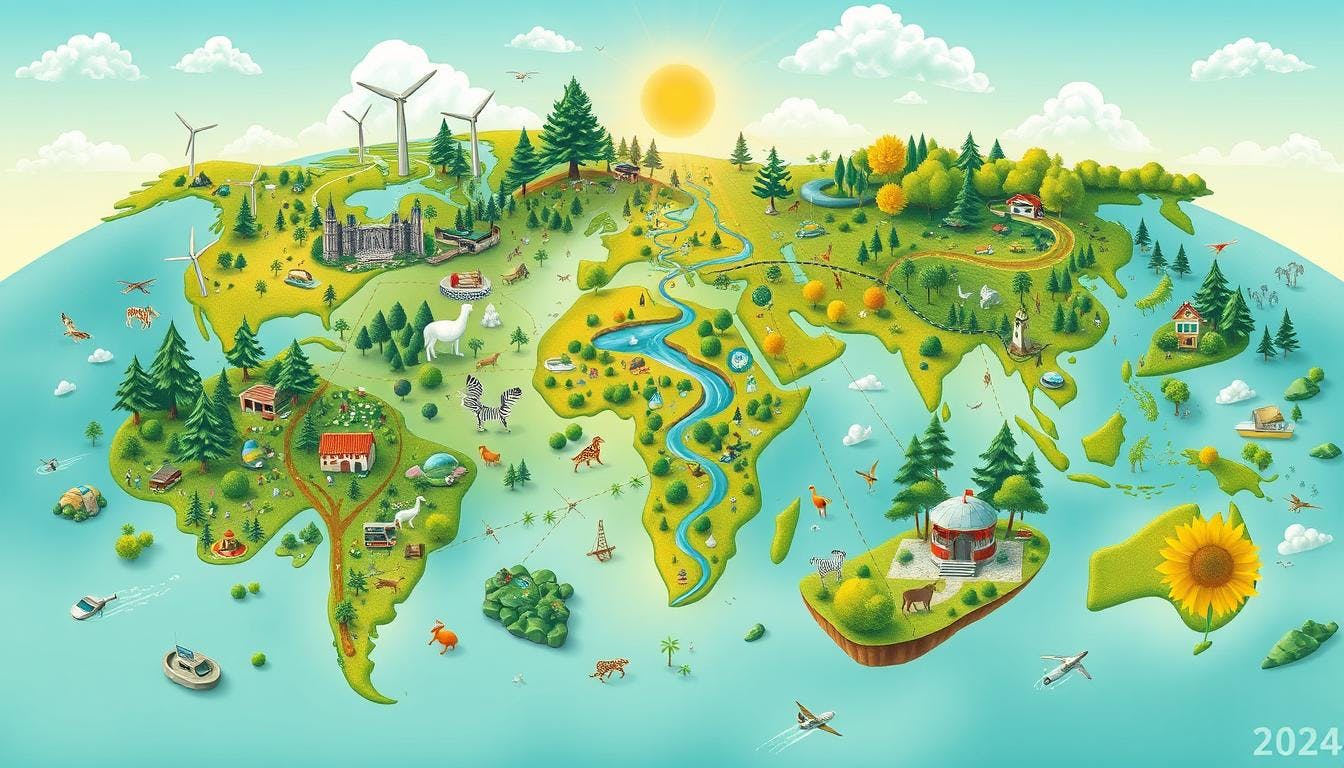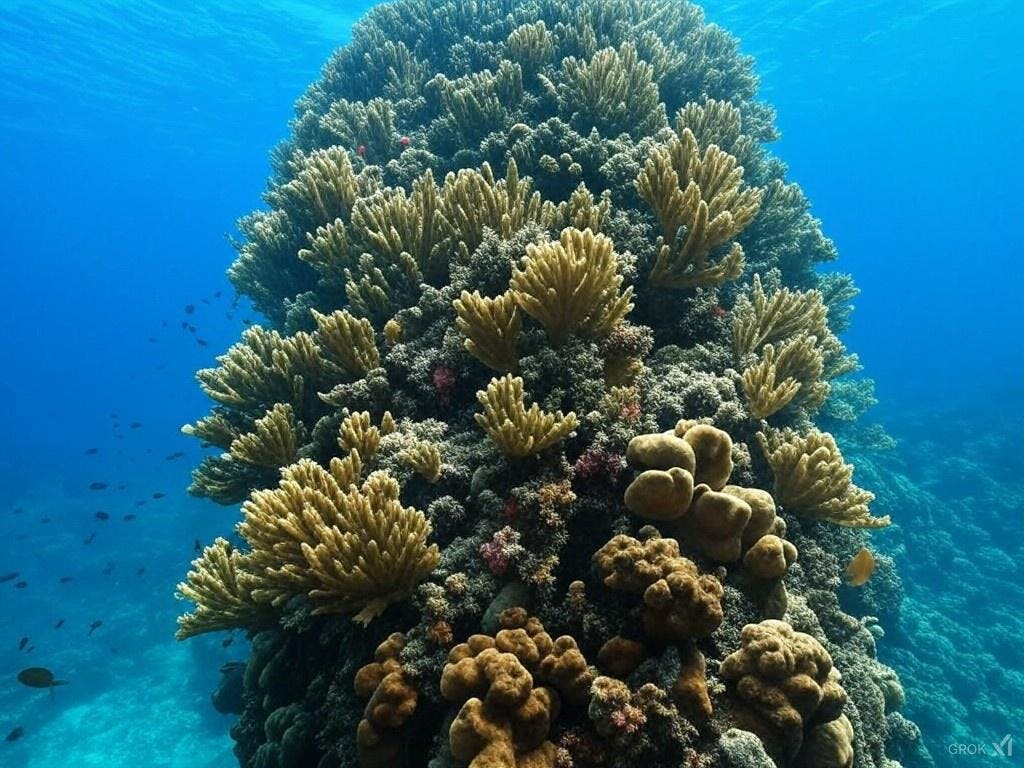Go the extra mile
Towards a cooler planet
Inspiring positive environmental stories 2024
9 January 2025
2024 was a year of substantial progress for our Earth. We're witnessing increased public action to address environmental challenges. This demonstrates our collective capability to resolve significant ecological issues.
Renewable energy adoption continues to accelerate, whilst innovative approaches to environmental conservation emerge. Governments, corporations, and community organisations are forming partnerships. Their collaborative efforts focus on creating lasting environmental sustainability.
This year marks a decisive moment for our environment. We're observing significant progress in conservation and technological advancement. Researchers, environmental advocates, and decision-makers are developing collaborative solutions to address global warming.
The developments of 2024 showcase our resilience and innovation. Each achievement advances us towards environmental sustainability. It illustrates how collective action creates meaningful impact.
We've examined over 200 remarkable initiatives from 2024. They demonstrate our capacity to restore natural systems and address climate change. These accounts provide optimism and illuminate effective approaches to substantial environmental challenges.

The rise of climate action: Tracking progress in 2024
2024: Global Climate Solutions in Action.
Leading nations have launched groundbreaking initiatives that reshape our approach to environmental protection. A surge of policy innovations and technological breakthroughs demonstrates unprecedented momentum in climate response.
Key breakthroughs this year include:
- Investments exceeding $500 billion in next-generation clean technology
- Integration of AI-powered smart grids across major cities
- Certain industry-wide adoption of zero-emission manufacturing
- Implementation of stringent carbon pricing mechanisms
The transition from policy to practice is accelerating. Some advanced solar arrays now achieve 40% greater efficiency, while floating wind farms open new possibilities for renewable deployment. These practical solutions are transforming abstract goals into tangible results.
Cross-border collaborations have reached new heights, with regional blocks forming unified climate strategies. The Asia-Pacific Climate Alliance and European Green Coalition exemplify this shift toward coordinated action.
Industry reports reveal concrete achievements:
- 15 nations have exceeded their 2024 emission reduction targets
- Breakthrough energy storage in some new solutions show 300% capacity improvement
- Public support for climate legislation reaches record high levels globally
This year's achievements suggest that coordinated global action delivers measurable environmental benefits.

Positive environmental stories 2024: Monthly highlights and achievements
The year was a significant period for environmental progress. It witnessed numerous conservation achievements and sustainable technology advancements worldwide. Each month brought new innovations that demonstrated our increasing commitment to environmental stewardship.
Notable environmental achievements included:
- January: Solar energy capacity increased by 35% in developing countries
- February: Coral reef restoration initiatives launched in three Pacific nations
- March: Advanced carbon capture technology reduced industrial emissions
- April: Reforestation programmes reclaimed 50,000 acres of land
- May: Sustainable agricultural projects enhanced farming practices globally
Sustainable technology proved crucial for environmental advancement. Innovative solutions emerged in renewable energy, waste management, and ecosystem preservation. Organisations and communities collaborated to address climate challenges.
Conservation achievements inspired global action. Wildlife protection expanded, marine conservation strengthened, and urban initiatives demonstrated the feasibility of substantial environmental changes.
2024 showed us the power of working together for the environment. Each achievement was a step towards a better, more sustainable world.
Groundbreaking nature conservation: Beehives and elephant protection in Kenya
Researchers in Kenya have developed an innovative approach to wildlife conservation. They implemented beehive fence systems to improve coexistence between farmers and elephants. A nine-year study demonstrated the effectiveness of beehive fences in deterring elephants from agricultural areas.
The study revealed compelling results. The beehive fences:
- Prevented 86% of elephant incursions into croplands
- Enhanced agricultural security for local communities
- Preserved elephant habitats without disruption
This method represents significant progress in wildlife and human protection. It enables farmers to safeguard their crops whilst maintaining environmental integrity. The approach benefits all participants.
The system provides additional advantages for bees and farmers alike. Bees receive protected habitats, whilst farmers generate additional income through honey production. The outcome serves multiple beneficial purposes.
Experts says this methodology offers valuable insights globally. It demonstrates the possibility of protecting both human communities and wildlife through innovative, sustainable solutions.


Montana's historic climate ruling: A victory for youth activists
A significant environmental case in Montana has created substantial legal precedent. The Montana Supreme Court established that individuals have a constitutional right to a clean environment. This ruling marks a notable victory for youth environmental advocates.
Sixteen young individuals, aged 7 to 23, initiated this legal action. They challenged the state's fossil fuel regulations, arguing these provisions inadequately protect their future. They sought enhanced environmental protection measures.
- The lawsuit examined state-level environmental assessment practices
- Advocates demonstrated how existing policies undermined environmental protection
- The ruling establishes significant precedent for constitutional environmental rights
This judicial decision marks a crucial development in environmental legislation. The court determined that pollution infringes upon constitutional rights. The youth plaintiffs successfully demonstrated the inadequacy of existing regulations.
This outcome illustrates the effectiveness of youth advocacy in environmental protection. They utilised legal frameworks to advocate for environmental preservation. Their success may inspire similar actions elsewhere.
Legal scholars consider this a watershed moment in environmental law. It establishes environmental protection as a fundamental right. This precedent could influence environmental litigation in other jurisdictions.
Rewilding success stories: Scotland and Wales lead European conservation
The United Kingdom is pioneering ecosystem restoration efforts. Scotland aims to become the first country to fully restore its natural landscapes. They have established partnerships with numerous environmental organisations to transform landscapes and preserve wildlife.
The Scottish Rewilding Alliance leads significant habitat restoration initiatives. Their primary objectives include:
- Reintroducing native species
- Preserving endangered wildlife corridors
- Restoring degraded ecosystems
- Engaging local communities in conservation
Wales has also initiated substantial environmental restoration efforts. They have launched an ambitious landscape rehabilitation project. This initiative is scheduled to commence in spring 2025, supported by environmental conservation funding.
Scotland and Wales are demonstrating effective ecosystem restoration approaches. Their methodology combines scientific research, community participation, and strategic land management. This establishes a notable precedent for European conservation.
Their objective is to create biodiverse landscapes supporting varied wildlife populations. The focus remains on strengthening natural systems and demonstrating the feasibility of substantial environmental transformation.


Breakthrough discoveries: New species found in Peruvian rainforest
Scientists from Conservation International have documented remarkable discoveries in the Alto Mayo Landscape. Their research revealed 27 previously unknown species within Peru's rainforests. These findings demonstrate the exceptional biodiversity of the region's ecosystems.
The research team documented several significant discoveries:
- 4 new mammal species
- 8 unique fish species
- 3 distinctive amphibian species
- 10 previously unidentified butterfly species
Preserving rainforests remains essential for sustaining these ecosystems. The research emphasises the importance of safeguarding landscapes influenced by human activity. Each newly discovered species presents potential opportunities for scientific and medical advancement.
Even in well-studied regions, nature continues to reveal unexpected discoveries. These findings underscore the necessity for additional research and conservation efforts. Preserving these areas ensures future generations can experience the remarkable biodiversity of our planet's rainforests.
This research represents the beginning of a broader initiative. Continued efforts remain essential to understand and preserve these crucial environments.
Sustainable energy innovation: Heat pump revolution in Europe
European countries are pioneering renewable heating through heat pump technology. This innovative system is transforming perspectives on energy efficiency. It facilitates the transition to sustainable heating solutions for residential properties.
In Stockholm, renewable energy companies are revolutionising residential heating approaches. Their subscription-based models reduce installation costs substantially. This system increases accessibility to renewable heating technologies.
- Heat pump networks can achieve a 70% reduction in carbon emissions
- Energy efficiency demonstrates 300-400% improvement compared to conventional heating systems
- Subscription models enhance affordability of renewable technology for property owners
In the UK, urban regeneration projects demonstrate significant advancement with heat pump implementation. A London housing estate dating from the 1900s serves as an exemplar for renewable heating adaptation in heritage buildings. It demonstrates the compatibility of modern renewable energy systems with existing infrastructure.
The European heat pump market continues rapid expansion. Governments are providing substantial incentives to support residential and commercial transitions to sustainable heating. This represents significant progress towards environmental targets and emissions reduction.


Marine conservation milestones: World's largest coral discovery
Scientists have documented a remarkable discovery in marine conservation. They identified an extensive coral organism in the Solomon Islands. This coral specimen exceeds previous size records, measuring 34 metres wide and over 5 metres tall.
The coral exhibits exceptional characteristics including:
- Dimensions surpassing those of a blue whale
- Detection possible through satellite imagery
- Demonstrated resilience in challenging marine environments
- Represents significant advancement in understanding coral adaptation
This finding holds substantial implications for marine conservation. The coral's robust structure demonstrates successful adaptation to elevated ocean temperatures. Marine biologists suggest its characteristics could inform coral ecosystem preservation worldwide.
Research confirms this specimen as the largest documented single coral structure. Its discovery provides encouraging evidence for scientists. The finding emphasises the importance of continued research and preservation initiatives.
Future research will examine the coral's genetic composition, growth patterns, and stress response mechanisms. This discovery marks significant progress in scientific understanding. It may lead to advanced approaches for marine ecosystem preservation.
Corporate environmental leadership: Business initiatives for climate action
Leading companies are transforming their approach to environmental stewardship. They're integrating sustainability into their core business strategies. This demonstrates how collective action can create substantial environmental impact.
Patagonia exemplifies this transformation. They closed their US stores on election day to encourage civic participation. Their CEO called upon other business leaders to support employee voting initiatives.
- Place environmental considerations at the forefront of corporate decisions
- Develop flexible workplace policies supporting civic engagement
- Incorporate sustainability objectives into organisational culture
Other major corporations are implementing similar initiatives. Technology firms, outdoor retailers, and global manufacturers are developing comprehensive sustainability strategies. Their objectives include:
- Decreasing carbon emissions
- Adopting sustainable technology
- Advancing environmental education
Employee engagement proves essential to these initiatives. Companies observe that environmental stewardship enhances team satisfaction and attracts talented professionals. These individuals seek opportunities to create meaningful impact.
The momentum for corporate environmental leadership continues to grow. This illustrates how businesses can contribute significantly to addressing global environmental challenges.


Global climate collaboration: UK-Australia sustainable energy partnership
The United Kingdom and Australia have established a partnership to address environmental challenges. Their collaboration focuses on renewable energy, creating a foundation for sustainable innovation.
Key aspects of the partnership include:
- Collaborative research on renewable hydrogen technologies
- Joint offshore wind energy development initiatives
- Shared investment in environmental protection strategies
- Technology transfer and knowledge exchange programmes
This partnership represents significant progress in addressing environmental challenges. Through resource sharing, they aim to accelerate renewable energy adoption. Their focus includes developing innovative approaches to reduce carbon emissions and establish sustainable infrastructure.
Their priorities encompass advancing hydrogen production efficiency, offshore wind installations, and renewable energy storage solutions. This collaboration demonstrates how international partnerships can advance environmental progress.
Leaders from both nations emphasise the importance of cooperation in renewable energy development. This partnership reflects their commitment to addressing global environmental challenges through technological and scientific advancement.
Urban sustainability: Cities leading environmental change
European cities are pioneering sustainable urban development. Cities such as Glasgow and London are implementing innovative methods to reduce carbon emissions. They're enhancing urban environments through sustainable transport systems and energy-efficient buildings.
The British Library in London exemplifies advanced infrastructure design. It houses the UK's largest solar heat system, demonstrating how significant structures can contribute to environmental preservation. Glasgow is innovating with electric wallpaper technology to reduce energy consumption.
Research indicates leading European cities are advancing sustainable transport solutions. They're expanding accessibility to electric vehicles, public transport networks, and cycling infrastructure. These urban centres are demonstrating effective approaches to environmental integration.
European cities are rapidly transforming to improve energy efficiency. They're proving that sustainability is achievable in major urban areas. These changes enhance both environmental preservation and urban living quality.

FAQs'
What are the most significant environmental achievements in 2024?
2024 has marked substantial progress. We've witnessed expansion in renewable energy and pivotal environmental rulings. The Montana Supreme Court's decision stands as a notable example. Additionally, researchers documented new species in Peru and implemented wildlife protection strategies in Kenya.
How are cities contributing to sustainability in 2024?
European cities are demonstrating leadership. They're implementing innovative technologies, including Glasgow's electric wallpaper. London's British Library utilises solar heat systems. Cities are advancing sustainable transport to reduce emissions.
What new conservation strategies are emerging?
Innovative approaches continue to develop. Scotland aims to become the first 'rewilding nation'. Nature-based solutions include beehive fence systems. The discovery of an extensive coral formation in the Solomon Islands demonstrates ecosystem resilience.
How are companies supporting environmental action?
Organisations are increasing their involvement. Patagonia provides electoral participation leave for employees, prioritising environmental considerations. Aira enhances renewable energy accessibility through heat pump subscription services.
What international collaborations are advancing environmental initiatives?
The UK and Australia have established a partnership. Their focus includes renewable energy development, particularly hydrogen technology and offshore wind. This demonstrates the significance of international cooperation on environmental matters.
How are young people influencing environmental policy?
Montana's youth achieved significant impact. Their Supreme Court victory established environmental rights precedent. This demonstrates youth effectiveness in environmental advocacy.
What biodiversity discoveries have been made in 2024?
Researchers in Peru identified 27 previously unknown species. These include mammals, fish, amphibians, and butterflies. This highlights rainforest ecosystem biodiversity.
How is renewable energy expanding in 2024?
Renewable energy adoption continues accelerating. Organisations like Aira enhance accessibility to sustainable energy. International partnerships advance renewable energy solutions globally.
17 South Street
Auckland 1010
New Zealand
info@carbonclick.com- -
- X
Sign up. Be inspired. Get clicking.
Subscribe now to stay up to date with CarbonClick, carbon offsetting and climate action.
By signing up you agree to our Privacy Policy.


